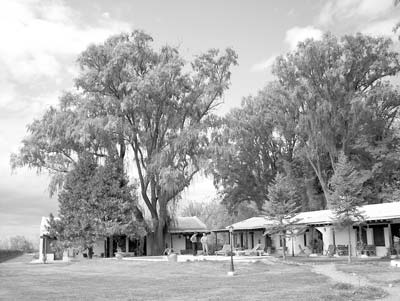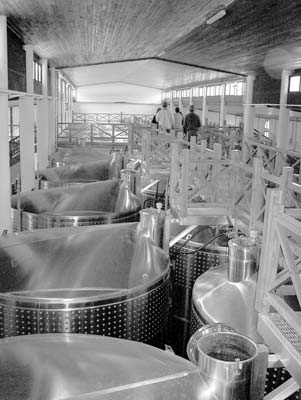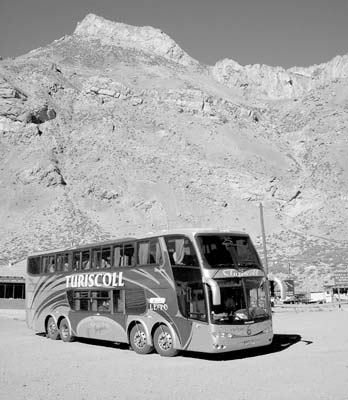Mendoza — wine and more
I had the opportunity to travel to Mendoza, the attractive city of 100,000-plus in the heart of northern Argentina’s booming viticulture region, in April ’06. While the city is a thriving regional commercial center, it is the huge wine industry — featuring literally scores of wineries (bodegas) in Mendoza and the surrounding districts — that primarily provides both its national identity and its popularity with foreign visitors. Mendoza has an annual 3-day wine festival the first weekend of March.
Mendoza city
In Mendoza, despite at times the seemingly hectic pace in and around the city center, residents are known for the way in which they celebrate the quality of life afforded by the healthy, dry highland climate, one conducive to outdoor-oriented activities.
For Mendoza locals, celebrating life by enjoying friends and family through socializing seemingly takes precedence over almost everything. In terms of having their life priorities in correct order, they might just have a model society. This is quickly observed when enjoying one of the many pleasant outdoor dining venues.
In Mendoza, founded during the colonial era and virtually destroyed by a powerful earthquake in 1851, trees hold great importance. Thousands have been imported from areas around the globe, and local residents are very proud of their beautiful tree-lined streets.
Particularly impressive is Parque San Martin, proportionally one of the largest city parks in the world for a city of Mendoza’s size. On the weekends the park is filled with both locals and visitors hiking, biking, rowing on the lake, picnicking and enjoying countless other activities. The highly regarded university also borders the park.
I salivated over the discovery of three separate public clay court tennis centers and a fine equestrian center within the park’s boundaries. And, providing great views over the city, a winding road leads to a lookout point at the top of a hill in the park.
Mendoza definitely has a relaxed European feel and look due to its noteworthy Italian immigrant heritage. Those physical and cultural characteristics are clearly apparent in the generally fit and trim local population.
In the center of Mendoza around Plaza Independencia and the adjacent walking mall, outdoor café dining, people-watching and strolling seem to be as much a living art form as it is in Mediterranean Europe. Mendoza is well endowed with museums and all the cultural accoutrements of a larger city, but, sadly, my schedule allowed only a surface inspection of its offerings.
The wine regions
I had come to experience and explore the wine country, visit some wineries and generally gain some insight into what all the Mendoza buzz in international travel circles is about. My accommodations and touring were provided by Postales del Plata, an American-owned tour company with offices in the USA and Mendoza. My fabulous guide, Nelo Luis Morichi, did much to educate me and unveil many of the region’s attractions.
My touring included, in addition to Mendoza city, three of the four wine districts in the greater Mendoza region: Region One, or the Central Region, extending both southwest and southeast of the city; Region Two, farther southeast of the city, and Region Three, Valle de Uco, a 45-minute drive to the south. Region four, the Southern Region, 200 kilometers south of Mendoza, will be saved for another visit.
Accommodation in the burbs
My Mendoza accommodation, Chacras de Coria Lodge ($150 per night per double room, including breakfast), is a small, upscale lodge located in Chacras de Coria, an upscale suburb about 15 minutes from the city center and 25 minutes from the Mendoza International Airport. The lodge is owned and operated by Postales del Plata along with Valle de Uco Lodge, which I would visit later.
Chacras Lodge has finely appointed guest rooms, a restaurant, a bar, a swimming pool and a friendly, caring, multilingual staff. A range of activities is offered, including spa services.
Chacras village, a short walk away, was especially alive and fun in the evenings, with a wide selection of restaurants and, on weekends, outdoor entertainment in the village square. Interestingly, at the Mar & Monte Restaurant, far from the sea, I experienced one of my finest seafood meals ever — shrimp entrée, reineta main course and wine for $30 per person. Fortunately, I had an opportunity to work some of the meal off the next morning on the red clay tennis courts near the restaurant.
I greatly enjoyed the lodge, its setting providing an attractive alternative to accommodating in the city plus the opportunity to experience locals where they live and play. Unlike many other areas of South America, even some of the upper-end Mendoza suburbs seem much like a one-room schoolhouse, with luxury residences and modest dwellings coexisting side by side in a tapestry of harmony that really seems to work, sans pretentiousness.
Wine touring
One of the biggest challenges for visitors with a relatively short period of time is determining which wineries to visit. My Postales del Plata hosts scored high marks in this regard, providing three decidedly different winery experiences.
My first was to the Carlos Pulenta winery Lujan de Cuyo, in Vistalba in Region One. It’s a new winery whose architecture was inspired by native cultures and utilizes cutting-edge technology while at the same time paying tribute to traditional methods of wine making.
Their underground tasting room features an educational soil display revealing just how hard the vines must work to achieve success in the arid soils of the Mendoza region. The 57-year-old vineyard produces uppermost-quality grapes, harvested manually, for its range of fine blended wines.
The traditional irrigation system and rough characteristics of the soil make the conditions perfect for the production of the region’s famed Malbec. Water from the Mendoza River comes through drainage channels, branches, irrigation ditches and tracks to the roots of the vines in the stony soil. Rows of olive trees are also used to protect the vines.
Later in the day I traveled south to Valle de Uco for a private visit to the highly acclaimed Lurton Winery. Their vineyards are spread over two sites: Vista Flores, at the winery and at 3,400 feet in elevation, and Barrancas, to the east of Mendoza on the plateau at 1,900 feet.
These virgin locations were selected for the combined quality of the soil, climate and water. The backdrop of snowcapped Andes provides scenic vistas for winery visitors.
Lurton is particularly well known for its outstanding Malbec and excellent low-yield Cabernet Sauvigon, with 87% of the yield exported. A special feature — this winery does not use stainless steel but rather temperature-controlled cement/epoxy tanks. All grapes are hand picked in small trugs (baskets) to prevent crushing.
Valle de Uco Lodge
One definite highlight of my Mendoza visit was an overnight at Valle de Uco Lodge ($200 per night per double room, including breakfast) in a picture-perfect setting of manicured lawns plus gardens shaded by old-growth trees, surrounded by fruit orchards and 7.5 acres of Malbec vineyards.
The eight spacious guest rooms, main lodge and dining room all look over the vineyards straight toward the glacier-draped Andes. Most international guests, self-drive and otherwise, stay two to seven days, allowing ample time to relax and enjoy the lodge environment, visit a selection of the excellent local wineries (currently 14 but expanding) for tours and wine tasting and engage in other activities such as horseback riding. The lodge uses local wine hosts for winery visits, insuring quality experiences.
On my return north the next day I enjoyed the continuous westward Andes spectacle, including views of awesome Cerro Plato at over 18,000 feet.
Tapaus
My guide, Neilo, graciously allowed me to alter my itinerary, replacing a scheduled winery visit with a stop at Tapaus, a high-end distillery that produces a range of 15 premium spirits. I was impressed upon learning that Tapaus does not use additives in the distillation process.
My educational behind-the-scenes tour culminated in a tasting session. A sensational pomelo (grapefruit) liqueur captured my taste buds’ gold medal, thereby earning return carry-on luggage space along with the silver medal choice, mandarin.
Casa Vinicola Reyter
My final stop was at Casa Vincola Reyter in Region Two, only 10 minutes from the city of Mendoza. Reyter, which was started by a family of Italian immigrants in 1900, today specializes in the fine science of champagne making. I toured their specially adapted facilities, learning much about the very precise champagne production process.
Following the tour, I retired to Reyter’s inviting champagne cellar for tasting of all three types of their champagnes and a bountiful lunch hosted by the gracious proprietors.
Bodega visitation advisory
Reservations are required at most bodegas, with tours usually lasting 45 minutes to an hour. Most wine tours are free and include tasting, but many wineries accept only cash (pesos) for wine purchases. Most bodegas are closed on Sundays.
Finally, if you are driving on your own, bring a good map, a flask full of patience and a sense of adventure.
Air to Mendoza
My air to South America was provided by the LAN alliance (call 866/435-9526 or visit www.LAN.com), which services Mendoza from North America via both Santiago and Buenos Aires.
LAN continues to gain acclaim in terms of industry ratings for its quality services, and it operates daily from North America via its New York, Miami and Los Angeles gateways to Argentina, Brazil, Chile, Colombia, Ecuador, Peru, Uruguay and Venezuela.
LAN is affiliated with American Airlines, utilizing their network of flight connections from 29 cities throughout the USA and Canada. LAN customers can also earn American AAdvantage frequent-flyer miles.
Driving to Mendoza
I drove with a friend to Mendoza from Chile via Portello Ski Resort on a very scenic route through the Andes.
Be advised that special arrangements must be made and insurance must be acquired in conjunction with auto rentals to allow travel between the two countries. Also, at times the border crossing can be subject to delays due to weather and traffic congestion.
Some Spanish-language capability is also helpful at the border.
Contact
In addition to their lodges and wine touring programs, Postales del Plata provides itineraries for individuals and groups of all types, including trekking excursions, horseback riding, hunting, estancia visits, fly-fishing adventures and mountain activities, such as skiing (in season), to destinations not only in and around Mendoza but throughout Argentina.
Rates run $77 to $125 per person per day for general guided winery touring.
Contact their U.S. office for information and bookings: Postales del Plata (1505 L Avenue, La Grande, OR 97850; call 866/963-7870 or visit www.postalesdelplata.com).
Keck's Beyond the Garden Wall
❝If a person died but awoke later in Mendoza,
Could the former occurrence be called other than
A passing of good fortune? ❞
— Randy considering Mendoza as a pretty neat place in the universe to inhale oxygen



